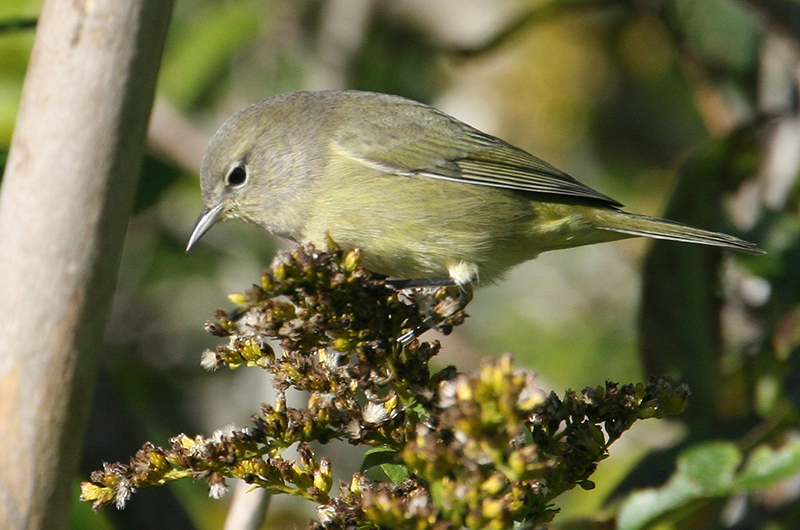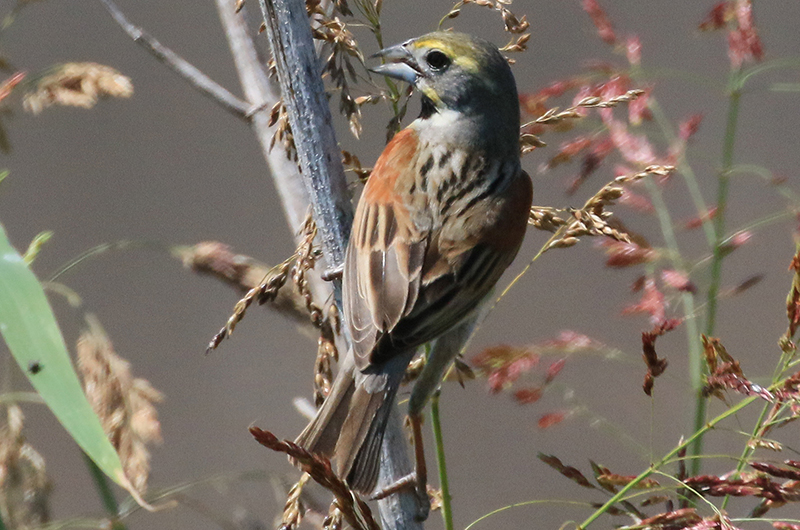It is September now — a new month and a new stage of avian migration. Songbirds are our focus rather than the shorebirds of August. Not that shorebirds are gone, but now the songbirds are pouring through. So our attention turns to the Gay Head Cliffs, the westernmost part of the Island, where the migrating songbirds congregate and wait for favorable weather before heading westward across the ocean. Bird activity can get quite intense there.
Susan Whiting, Pat Hughes, Pete Gilmore and Luanne Johnson all converged on the Gay Head Cliffs early on the morning of Sept. 9. They had a good morning, adding three non-descript species that had not been observed so far this year.
First, they found a dickcissel, a nondescript house sparrow look-alike except for the yellow patch on their breasts. This species has become an annual visitor to the Island at this time of the year and its distinctive buzzy “dzzrt” call can help to locate and identify them.
A clay-colored sparrow is the second species, spotted by Pete Gilmore that same morning at the cliffs. This species is a little brown job that is difficult for most of us to identify because it so closely resembles the chipping sparrow’s non-breeding plumage. Two distinguishing field marks are rump color (good luck!) and whether or not the black eye-line extends past the eye to its bill.
Pete Gilmore also found the third new species, an orange-crowned warbler. This species can be drab gray, greenish or yellowish depending on how old it is and what part of the continent it came from. In any case, you are not likely to see its namesake orange crown. The other highlights of the above four birders were house wren, yellow and prairie warblers.
Tim Spahr, Pete Gilmore and Susan Whiting also visited the cliffs on Sept. 7, where they observed a flock of 60 bobolinks as they repeatedly headed out over the ocean only to chicken out and return to the safety of land (this is what many of the migrants do in the early morning). As they fly overhead, their “pink” call notes can easily be heard and recognized before they are seen. Other highlights included lesser black-backed gull, laughing gull, tree and barn swallows, red-breasted nuthatch, prairie warbler and Baltimore oriole. Then, elsewhere in Aquinnah, they added chimney swift, merlin, blue-winged warbler, purple finch and field sparrow, while Tim Spahr found a redstart and a Cape May warbler on his way home.
Susan McCoy and Sharon Cook visited the Gay Head Cliffs on Sept. 6 and found the bobolinks and a merlin.
Of course, you do not have to go to Aquinnah to see migrating songbirds; they will land anywhere after a long night of flying. Perhaps the most common warbler this week is the common yellowthroat, which seems to be just about everywhere. Luanne Johnson saw some on Sept. 8 at both West Tisbury’s Duarte’s Pond and at home near Majors Cove. Tim Spahr observed them on both Sept 6 and Sept. 8 at Sheriff’s Meadow Sanctuary, while my Sept. 8 guided birding tour found one at Quansoo Farm and there were several of them at Cedar Tree Neck when I visited on Sept. 2. Sarah Mayhew found some at Squibnocket on Sept 8.
Other species of warblers seen this week include a pine warbler by Luanne Johnson near her Oak Bluffs home on Sept. 8, two western palm warblers found on Sept. 6 by Pete Gilmore, and a female or immature American redstart — often called lemonstart because they have yellow rather than red patches — by Lanny McDowell on Sept. 8.
Ruby-throated hummingbird migration is also peaking. Susan Whiting, Pat Hughes, Pete Gilmore and Luanne Johnson found them in Aquinnah on Sept. 9, Luanne Johnson spotted one near Major’s Cove on Sept. 8, Tim Spahr found them at Sheriff’s Meadow Sanctuary on Sept. 8, Steve Allen spotted one at Felix Neck on Sept 6, I had one at my house on Sept. 5, and Sarah Mayhew found one in her yard on Sept. 1. These hummers are widespread now but most of them will soon depart for southern climes. Then the identification challenge begins when stray western hummingbirds may show up.
Pete Gilmore found an eastern kingbird in Aquinnah on Sept. 6. He visited Cedar Tree Neck on Sept. 9 and saw both a great crested flycatcher and a red-eyed vireo.
The influx of red-breasted nuthatches continues. Tim Spahr observed them at Sheriff’s Meadow Sanctuary on Sept. 8, and both Luanne Johnson and I have been observing multiple individuals around Waterview Farm. Maybe they will stay through the winter this year.
A brown creeper was found on Sept. 7 by Lanny McDowell at his house.
Bob and Polly Grose Quitsa Lane in Chilmark have enjoyed watching the bobwhite quail visiting their feeders all summer. They had 14 of them — the highest numbers of the summer —— on August 31; six of them were on a platform feeder eating sunflower seeds while the other eight were on ground eating thistle seed other birds dropped from the tube feeder above.
To conclude with a bit of shorebird news: on Sept. 8 Luanne Johnson found a pectoral sandpiper and a greater yellowlegs in a marsh near Major’s Cove. Tim Spahr found both piping plovers and a short-billed dowitcher at Little Beach on Sept. 5. And Walt Looney found four black terns in the flock of tern staging on that same beach on Sept. 4.
Southbound songbirds are now migrating through. Please report all your sightings to birds@mvgazette.com.
Robert Culbert leads Saturday morning Guided Birding Tours and is an ecological consultant living in Vineyard Haven.











Comments
Comment policy »